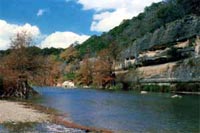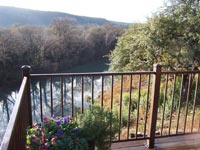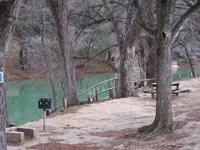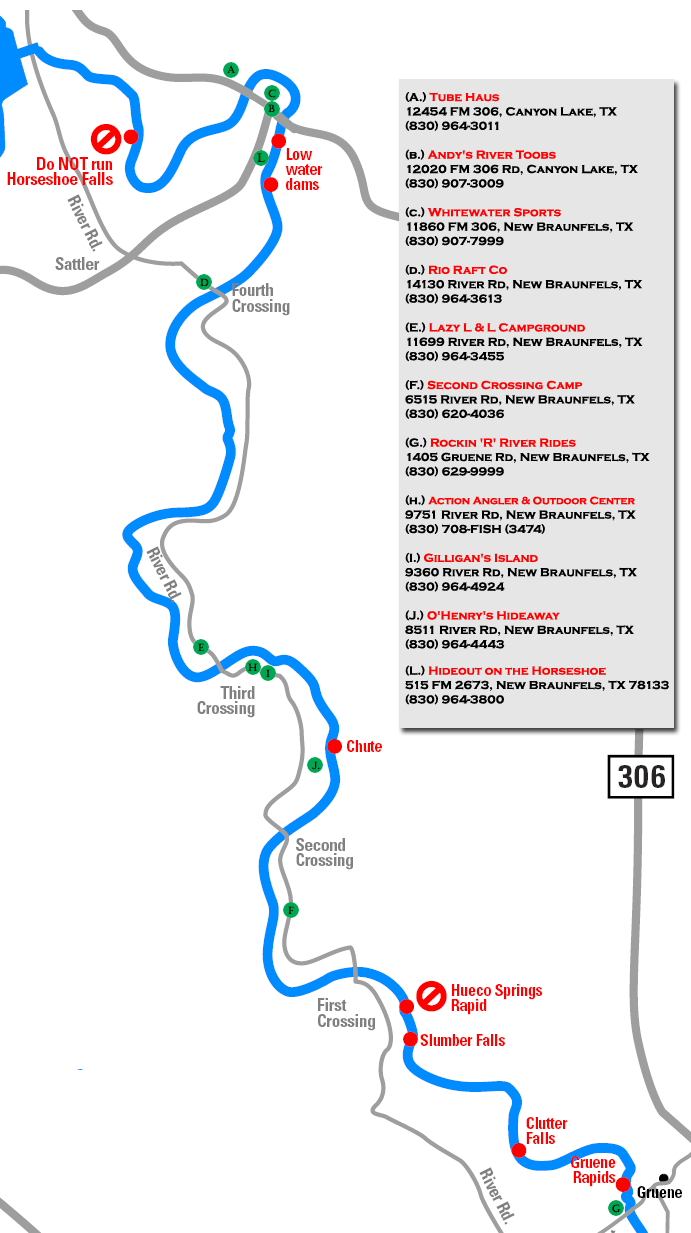The Guadalupe River is one of Texas’ most beloved and scenic waterways, stretching roughly 230 miles from its source in the Texas Hill Country to its mouth at the Gulf of Mexico. Its journey begins near Kerrville in Kerr County, where the river winds through picturesque landscapes, including lush forests and limestone bluffs, offering endless opportunities for outdoor recreation. Whether you’re looking to tube through calm waters, kayak down thrilling rapids, or simply enjoy the peaceful surroundings, the Guadalupe River delivers a quintessential Texas experience. Along the way, it passes through charming towns like New Braunfels, offering plenty of places to eat, stay, and explore. Join us as we discover where the Guadalupe River starts, where it ends, and everything in between!
History Of The Guadalupe River
The Guadalupe River was one of the earliest-explored rivers in Texas and was named for Our Lady of Guadalupe by Spanish explorer Alonzo de Leon in 1689. The Guadalupe River flows from Canyon Lake Dam 250 miles toward the coast and it supports some of the finest recreation spots in Central Texas. One of the most popular sections of the Guadalupe River is between the Canyon Lake Dam and Gruene and it is a paradise in the middle of the Texas Hill Country.
Enjoying The Guadalupe River
The most popular sections of the Guadalupe is famous because of the exciting rapids, sparkling clear waters, scenic views, and good fishing. The river cuts through tall limestone bluffs and towering cypress trees. There are occasional rapids, but for the most part the river flows along lazily. Along the river you will find restaurants, bars with live music, plenty of outfitters, and a number of places to stay from tent camping to large houses to resorts with outstanding views of the river and the surrounding hills. The links below can help you find an outfitter and place to spend the night.



But the real reason most people visit the Guadalupe River is to enjoy the clear cool waters on a hot day with hundreds of their new found friends. Whitewater rafting, canoeing, and kayaking are very popular, but tubing seems to be the mode of choice. In fact millions of people rent tubes, rafts, kayaks, and canoes to float a 20 mile section of the river between the Canyon Lake Dam and New Braunfels every year. There are over two dozen outfitters along the river banks where you can rent tubes and canoes and buy concessions. Most outfitters offer a shuttle service to bring you back to your point of entry. Styrofoam and glass are prohibited on the river, and officers patrol the waters for safety. Help protect and preserve this beautiful area and river.
If you are not into tubing, then drive River Road. River Road is a 10.6-mile very scenic drive which crosses the Guadalupe River four times. Start the drive with breakfast at The Old Sattler Baking Company on FM 2673 in Sattler and end in New Braunfels. There is no stopping or parking allowed on the road but you will be treated with some beautiful country side and views of the river. Stop and enjoy some of the local establishments for food, drinks, or music – sit on their decks and watch the tubers float by.
Where Does The Guadalupe River Start And End?
The Guadalupe River stretches across Texas for approximately 230 miles. Beginning in the Texas Hill Country near Kerrville in Kerr County, the Guadalupe meanders southeast through scenic landscapes before flowing into San Antonio Bay at the Gulf of Mexico.
Spanish explorer Alonzo de Leon named the Guadalupe River after Our Lady of Guadalupe in 1689. One of the most popular sections of the Guadalupe River is between the Canyon Lake Dam and Gruene. This section of the river is a paradise in the middle of the Texas Hill Country.
All along the river you will find restaurants, bars with live music, plenty of outfitters, and a number of places to stay, from camping destinations to vacation rental homes to resorts with outstanding views of the river and its surrounding hills.
What Is the Guadalupe River Known For?
The Guadalupe River is a famous Hill Country waterway and known for its clear, spring-fed waters. This river plays an important ecological role by supporting all kinds of wildlife, birds, and various fish species and marine life. To add to its beauty and appeal for camping, hiking, and tubing, ash, bald cypress, cedar elm, juniper, live oak, pecan, post oak, shin oak, and sycamore trees line the Guadalupe’s banks.
Is Guadalupe River Safe to Swim In?
Yes, the Guadalupe River is generally safe to swim in and especially in its most popular recreational areas like New Braunfels and near Canyon Lake. Visitors canoe and kayak, swim, and tube in its cool, clear waters year-round, but summer is the busiest time. Safety conditions vary depending on several factors.
Water Levels: The Hill Country’s river safety can fluctuate based on water levels, which are influenced by rainfall, dam releases, and drought conditions. After heavy rainfall, Hill Country rivers rise quickly and develop swift and dangerous currents. It is important to check water levels and flow rates before swimming or tubing with local authorities.
Designated Areas: Some parts of the river are safer than others, like those monitored and maintained for recreation in state parks or sections near popular tourist spots. Swim in well-known areas where safety measures are monitored.
Debris and Obstacles: In the Hill Country rivers, submerged rocks, trees, and debris create potential hazards, especially in less-developed areas or after rainstorms.
Wildlife: Wildlife explodes in the Hill Country rivers. Fish, turtles, and an occasional water snake may float beside you. These marine animals are usually harmless and typically avoid highly trafficked human areas.
Can You Float the Guadalupe River?
Yes, and there are tons of access points and tube rental outfitters that offer pickups for return trips to your point of access. Or, you can bring your own tubes and arrange your own transportation back to your starting point.
One of the most popular sections to float on the Guadalupe River is between the Canyon Lake Dam and Gruene. Locals relish this paradise in the middle of the Texas Hill Country.
Map Of The Guadalupe River From Canyon Lake To Gruene

What City Is Close to the Guadalupe River?
Several towns rest near or right on the banks of the Guadalupe River or the river flows through them. These towns provide excellent access to different sections of the Guadalupe River. They offer their own unique personalities with both bustling and more secluded tubing experiences.
Cities and towns providing access to the Guadalupe River:
Boerne is famous for its German heritage, shopping, and its proximity to natural attractions like the Guadalupe River State Park. Boerne is a few miles west of the Guadalupe River and the Guadalupe River State Park in Kendall County.
Canyon Lake shows off as a stunning reservoir a few miles north of New Braunfels. The Guadalupe River flows into Canyon Lake. Tubing downstream from Canyon Lake is super popular. Canyon Lake provides great opportunities for boating, camping, and fishing near the Guadalupe River in Comal County.
Comfort lies near a more remote section of the Guadalupe River about 47 miles north of San Antonio in Kendall County. This small town in the Hill Country is ideal for those seeking a quieter experience on holidays and during peak tubing season. Comfort is also popular for canoeing and kayaking, fishing, and exploring some of the Hill Country’s wineries.
Kerrville is the charming Hill Country town near where the Guadalupe River headwaters originate. Peaceful riverside parks and scenic drives line this section of the river, like the Louise Hays Park. Kerrville lies in Kerr County and is 19 miles north of Comfort and 65 miles north of San Antonio.
New Braunfels is one of the most popular and busiest Guadalupe River towns for tubing, kayaking, and swimming on the Guadalupe and Comal Rivers. This historic town in Comal and Guadalupe Counties also presents the famous Gruene Historic District and attractions like Schlitterbahn Waterpark.
The San Marcos River is the Prima Donna in this town in Hays County. However, San Marcos, the town, is also close to the Guadalupe River. San Marcos is a wonderful location for accessing multiple Hill Country rivers. San Marcos features a vibrant downtown, and Texas State University calls San Marcus home.
Seguin also offers a quieter, less crowded segment of the Guadalupe River in Guadalupe County. Its historic downtown and outdoor activities like fishing and paddling on the river are popular, as well as its tubing access points. Seguin lies southeast of New Braunfels.
Victoria in Victoria County sits 43 miles north of where the Guadalupe River flows into San Antonio Bay on the Gulf of Mexico. Besides tubing, Victoria offers great spots for birdwatching, enjoying coastal Texas scenery, and fishing.
Are There Snakes in the Guadalupe River?
Yes, there are snakes in and around the Guadalupe River. Most of them are non-venomous and not aggressive toward humans. The river’s natural environment highlights lush vegetation, warm water, and rocky terrain, which provides a preferential habitat for several snake species.
Are There Alligators in the Guadalupe River?
Alligators are rarein the Guadalupe River, but its frequent human river rats have spotted these ancient reptiles occasionally, especially in the lower sections of the river near the Gulf of Mexico. Alligators are found more commonly in the coastal areas of Texas in the southeastern region of Texas.
Lower Guadalupe River: Visitors will more likely find alligators in this lower portion of the Guadalupe River, which is closer to where it empties into San Antonio Bay near Victoria. This region provides a natural gator habitat.
Upper and Central Guadalupe River: In the Hill Country near New Braunfels, Kerrville, and Canyon Lake, alligator sightings are extremely rare due to the river’s cooler water temperatures and this region’s less suitable gator habitats.
Are There Rules and Prohibited Items at the Guadalupe River?
Yes, there are specific rules and prohibited items related to floating on the Guadalupe River that ensure safety and environmental protection, and to offer an enjoyable experience for visitors. These regulations vary, depending on the section of the river and local law statues.
General Rules
- Children under a certain age, usually aged from 8 to 13 are required to wear personal flotation devices (PFDs).
- Age requirements depend on local, county, and state laws/rules along the river and in the many local jurisdictions.
- Life jackets are highly recommended for non-swimmers and when water levels are high.
River Tubes:
- Only approved flotation devices, like tubes and rafts, are allowed.
- Some areas prohibit tubes with bottoms to prevent littering.
No Glass Containers:
- Glass bottles or containers are strictly prohibited to prevent injuries and protect the river’s environment.
No Styrofoam:
- Styrofoam coolers or items made of Styrofoam are banned because they easily break apart and pollute the river.
Coolers:
- Coolers are allowed, but many areas limit them to one cooler per person and require a locking lid.
- Containers inside the cooler, like cans or bottles, must be reusable or disposable with proper care.
Littering:
- Littering is illegal, and most sections of the river require tubers to carry a mesh litter bag. Visitors can bring their own or obtain them from tubing rental outlets.
- Fines can be issued for improper disposal of trash.
Alcohol Restrictions
- Alcohol is permitted on the river, but there are rules. Certain areas may ban alcohol during specific holidays or on high-traffic weekends.
- No public drunkenness: Authorities actively patrol the river. Excessive intoxication or disruptive behavior can result in fines or removal from the river.
Noise and Behavior
- Loud music and excessive noise is discouraged in many sections of the river.
- Offensive behavior, like public indecency or intoxication, can result in fines or arrest.
High Water Conditions
- During times of high water levels after heavy rainfall, the river may be closed for safety reasons. Always check local advisories for closures or restrictions.
Restricted Items
- Weapons: Firearms and other weapons are generally prohibited.
- Motorized Watercraft: Only non-motorized vessels, like canoes, kayaks, and tubes are allowed on most parts of the river.
Holiday and Peak Season Rules
- On Memorial Day, Fourth of July, and Labor Day, extra rules may apply, such as stricter alcohol restrictions and more patrols.
Local Ordinances in New Braunfels
New Braunfels, one of the most popular tubing spots, has additional regulations:
- Cans per person limit: Each person may be limited to a specific number of drinks on the river, like no more than one six-pack per person at a time.